语言学术语解释和举例
语言学常考的名词解释有哪些

语言学常考的名词解释有哪些语言学是一门研究语言的学科,它涉及对语言的结构、语言习得、语言使用等方面的研究。
在语言学的学习中,名词解释是一个常见的题型,要求学生对语言学术语进行准确解释和阐述。
本文将探讨语言学常考的名词解释有哪些。
一、语音语音学是语言学的一个重要分支,它研究的是语言中的音素、音位、音系等。
语音学中的名词解释有声音、音位、音素等。
声音是指随着空气流动而产生的声波,是语言的基本要素之一。
它由声带振动产生,通过咽喉、鼻腔和口腔等发声器官的塑形作用而成为可以被听者感知的语音信号。
音位是指在某一语言中具有区别意义的音素单位。
不同的语言中,音位的数量和类型可能不同,比如汉语中的声调、英语中的元音和辅音等。
音素是构成语言中最小的语音单位,它是在一个语言中能识别出并区分意义的声音。
在不同的语言中,音素的数量和特点也不尽相同。
二、语法语法是语言学的核心内容之一,它研究的是语句的结构和组织规律。
语法中的名词解释有句子、词性、语法关系等。
句子是语言中的基本单位,它由词组成,有主语、谓语、宾语等成分,并且能够构成一个完整的意义。
句子可以分为陈述句、疑问句、祈使句等多种类型。
词性是指词语在句子中的语法功能和类别。
常见的词性有名词、动词、形容词、副词、介词等。
不同的词性在句子中扮演不同的角色,起到不同的作用。
语法关系是指词与词之间在句子中的联系和作用关系。
常见的语法关系有主谓关系、动宾关系、定语与被修饰词关系等。
通过语法关系,词语可以组成一个具有意义的句子。
三、语义语义是语言学的一个重要分支,它研究的是词语和句子的意义。
语义中的名词解释有词义、上下位关系、语用等。
词义是指词语所表示的概念或事物。
词义可以直接由词的形态和义素来表示,也可以通过上下文来理解。
一个词可能有多个词义,比如“车”可以指代交通工具,也可以指代编织器具。
上下位关系是词语之间的层级关系,其中上位词泛指某一概念,下位词则是具体到某一个类别。
比如,动物是上位词,猫、狗是下位词。
语言学名词解释
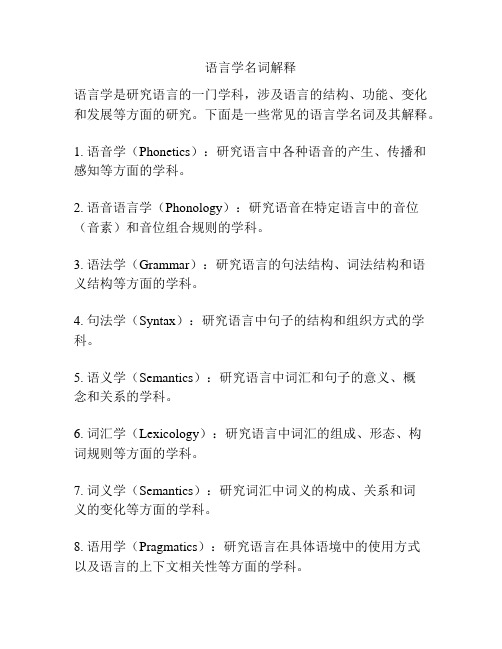
语言学名词解释语言学是研究语言的一门学科,涉及语言的结构、功能、变化和发展等方面的研究。
下面是一些常见的语言学名词及其解释。
1. 语音学(Phonetics):研究语言中各种语音的产生、传播和感知等方面的学科。
2. 语音语言学(Phonology):研究语音在特定语言中的音位(音素)和音位组合规则的学科。
3. 语法学(Grammar):研究语言的句法结构、词法结构和语义结构等方面的学科。
4. 句法学(Syntax):研究语言中句子的结构和组织方式的学科。
5. 语义学(Semantics):研究语言中词汇和句子的意义、概念和关系的学科。
6. 词汇学(Lexicology):研究语言中词汇的组成、形态、构词规则等方面的学科。
7. 词义学(Semantics):研究词汇中词义的构成、关系和词义的变化等方面的学科。
8. 语用学(Pragmatics):研究语言在具体语境中的使用方式以及语言的上下文相关性等方面的学科。
9. 文法学(Stylistics):研究语言使用中的文体、修辞手法、语言风格等方面的学科。
10. 母语(Mother tongue):一个人从小学会并用于日常交际的语言。
11. 第二语言(Second language):在学习者的母语之外学习的语言。
12. 语言接触(Language contact):不同语言之间在社会、文化接触中产生的相互影响和借用的现象。
13. 语言变异(Language variation):指同一个语言在不同社会、地理和使用者间发生的音、词、句法等方面的变化。
14. 语言变化(Language change):指语言在漫长的时间内逐渐变化和发展的过程。
15. 语言规范(Language standardization):制定和规范一个语言的正确用法、标准词汇和语法规则的过程。
16. 语言习得(Language acquisition):指儿童在自然环境中学习母语的过程。
语言学概论名词解释

1、口语:口语是语言的有声客观存在形式,是书面语产生的基础,相对于书面语是第一性的。
2、书面语:书面语是语言的客观存在形式之一,在口语的基础上产生,相对于口语是第二性的,是经过加工、提炼和发展了的口语的书面形式。
3、语言:语言是言语活动中同一社会群体共同掌握的,有规律可循而又成系统的那一部分,语言是均质的,是言语活动中的社会部分。
语言作为一种社会现象具有鲜明的地区性、民族性和历史性。
4、言语:是个人说的行为(说话)和结果(所说的话)。
5、符号:是根据社会的约定俗成使用某种特定的物质实体来表示某种特定的意义而形成的这种实体和意义的结合体。
6、能指:是语言符号的物质实体。
7、所指:是符号所指的意义内容。
8、语言符号的任意性:是指语言符号的物质实体和意义内容之间没有必然的理据关系。
9、语言符号的强制性:指语言符号在同一社会、同一时代,对使用同一种语言的每一个社会成员来说,是不能任意改变的。
10、聚合关系:在同一个位置上可以互相替换出现的各个语言单位处在互相可以联想起来的关系中,因而聚合成为一个类。
11、组合关系:在语言结构的同一层级上组合起来的各个单位之间所形成的关系。
12、普通语言学:指从理论上研究人类各种语言所共有的规律以及各种语言在结构上的共同特点的一门语言学分支学科。
它以一般语言学为研究对象,探索各种语言所共有的特性、共同的规律、结构上的共同特点和一般原理。
13、理论语言学:指从理论上研究人类语言的性质、功能、结构等的语言学分支学科。
以研究对象的不同,可分为个别语言学和一般语言学。
14、应用语言学:指运用语言学的理论知识来解决其他学科领域的各种问题的语言学分支学科,可分为狭义应用语言学和广义应用语言学。
(把语言学的理论和具体成果用来为社会实际生活中的某个领域服务,这是广义的应用语言学;狭义的应用语言学指专门研究语言教学中的理论和方法。
)15、传统语言学:一般泛指20世纪以前的语言学,特别是指索绪尔开创的结构主义语言学以前的语言学。
语言学名词
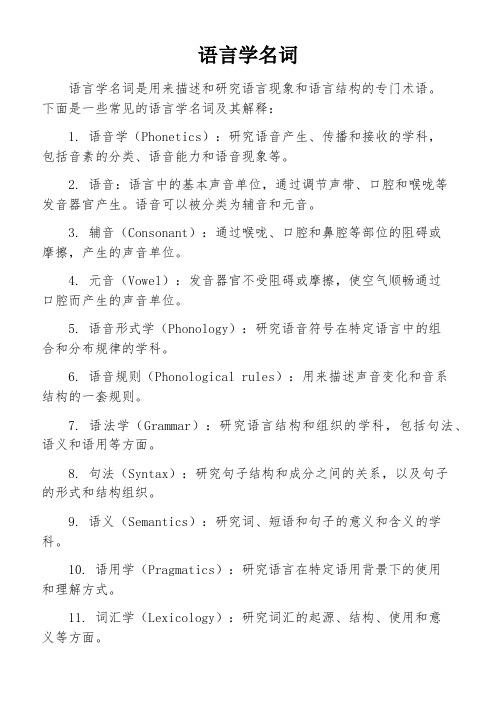
语言学名词语言学名词是用来描述和研究语言现象和语言结构的专门术语。
下面是一些常见的语言学名词及其解释:1. 语音学(Phonetics):研究语音产生、传播和接收的学科,包括音素的分类、语音能力和语音现象等。
2. 语音:语言中的基本声音单位,通过调节声带、口腔和喉咙等发音器官产生。
语音可以被分类为辅音和元音。
3. 辅音(Consonant):通过喉咙、口腔和鼻腔等部位的阻碍或摩擦,产生的声音单位。
4. 元音(Vowel):发音器官不受阻碍或摩擦,使空气顺畅通过口腔而产生的声音单位。
5. 语音形式学(Phonology):研究语音符号在特定语言中的组合和分布规律的学科。
6. 语音规则(Phonological rules):用来描述声音变化和音系结构的一套规则。
7. 语法学(Grammar):研究语言结构和组织的学科,包括句法、语义和语用等方面。
8. 句法(Syntax):研究句子结构和成分之间的关系,以及句子的形式和结构组织。
9. 语义(Semantics):研究词、短语和句子的意义和含义的学科。
10. 语用学(Pragmatics):研究语言在特定语用背景下的使用和理解方式。
11. 词汇学(Lexicology):研究词汇的起源、结构、使用和意义等方面。
12. 词(Word):语言中的基本意义单位,具有独立的意义和语法功能。
13. 词法(Morphology):研究词的内部结构、形态变化和构词法的学科。
14. 语素(Morpheme):语言中的最小意义单位,可以独立存在或者是其他词的构成组成部分。
15. 词义(Word meaning):词语所表达的概念或事物的内涵。
16. 语篇(Discourse):由句子和词组组成的扩展语言单位,表达完整的意义。
17. 修辞学(Rhetoric):研究语言如何用于说服和交流的学科。
18. 语族(Language family):具有共同源头和结构相似的一组语言。
《语言学概论》名词解释
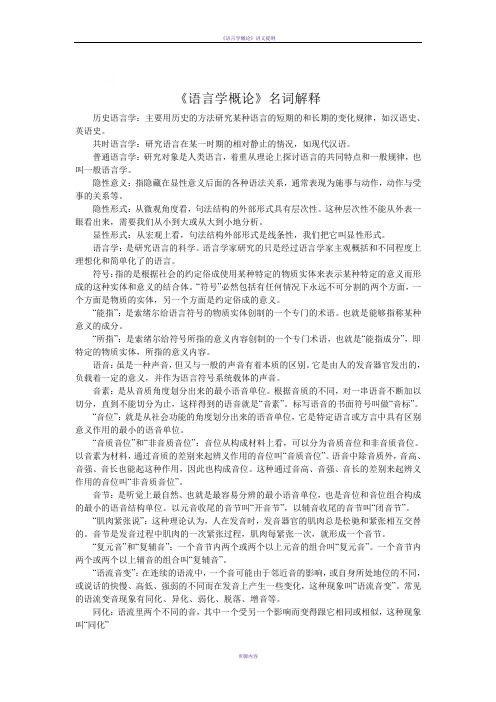
《语言学概论》名词解释历史语言学:主要用历史的方法研究某种语言的短期的和长期的变化规律,如汉语史、英语史。
共时语言学:研究语言在某一时期的相对静止的情况,如现代汉语。
普通语言学:研究对象是人类语言,着重从理论上探讨语言的共同特点和一般规律,也叫一般语言学。
隐性意义:指隐藏在显性意义后面的各种语法关系,通常表现为施事与动作,动作与受事的关系等。
隐性形式:从微观角度看,句法结构的外部形式具有层次性。
这种层次性不能从外表一眼看出来,需要我们从小到大或从大到小地分析。
显性形式:从宏观上看,句法结构外部形式是线条性,我们把它叫显性形式。
语言学:是研究语言的科学。
语言学家研究的只是经过语言学家主观概括和不同程度上理想化和简单化了的语言。
符号:指的是根据社会的约定俗成使用某种特定的物质实体来表示某种特定的意义而形成的这种实体和意义的结合体。
“符号”必然包括有任何情况下永远不可分割的两个方面,一个方面是物质的实体,另一个方面是约定俗成的意义。
“能指”:是索绪尔给语言符号的物质实体创制的一个专门的术语。
也就是能够指称某种意义的成分。
“所指”:是索绪尔给符号所指的意义内容创制的一个专门术语,也就是“能指成分”,即特定的物质实体,所指的意义内容。
语音:虽是一种声音,但又与一般的声音有着本质的区别。
它是由人的发音器官发出的,负载着一定的意义,并作为语言符号系统载体的声音。
音素:是从音质角度划分出来的最小语音单位。
根据音质的不同,对一串语音不断加以切分,直到不能切分为止,这样得到的语音就是“音素”。
标写语音的书面符号叫做“音标”。
“音位”:就是从社会功能的角度划分出来的语音单位,它是特定语言或方言中具有区别意义作用的最小的语音单位。
“音质音位”和“非音质音位”:音位从构成材料上看,可以分为音质音位和非音质音位。
以音素为材料,通过音质的差别来起辨义作用的音位叫“音质音位”。
语音中除音质外,音高、音强、音长也能起这种作用,因此也构成音位。
语言学名词解释

语言学相关名词解释1.方言:通常指地域方言,它是全民族语言在不同地域的变体,是统一的全民族语言的分支。
2.亲属语言:是语言分化的产物,凡从同一种语言中分化出来的若干语言都是亲属语言。
3.社会方言:一种语言或地域方言内部同一定的社会特征和社会群体相关联的变体和特点被称为“社会方言”。
在一个语言社会中,不同的人说话可能会使用不同的语言变体而呈现出不同的特点,这些不同的语言变体和特点又同说话人的社会特征相关联,同一定的社群联系在一起,这种语言或方言内部同一定的社会特征和社群相关联的变体和特点被称之为社会方言。
4.语系:谱系分类中最大的类,凡有亲属关系的语言都属于同一语系。
8.基础方言:作为民族共同语的基础的方言。
10.地域方言:同一种语言由于语音、语汇和语法等方面的差异而在不同地区形成的地域分支或变体。
13.借词:也叫外来词,主要指语音形式和语义内容都来自外语的词。
14.仿译词:意译词的一种,指那些用本民族语言的语素逐一翻译原词语的各个成分,不但把原词语的意义,而且把原词语的内部结构形式也移植过来的那些词。
15.意译词:词的语音形式和构词方式是本民族语言的,词义来自外语的词。
16.双语现象:一个社会同时使用两种或多种语言作为交际工具,它是民族的接触、尤其是民族杂居的产物。
17.语言转用:指一种语言取代其他语言而成为不同民族的共同交际工具。
18.洋泾浜语:这是汉语对混杂语言的称呼,指母语不同的人在相互交际时所使用的两种或多种语言混杂而成的交际工具。
19.克里奥耳语:作用某个社会群体的母语来使用的、由两种或多种语言混合而成的语言。
20.双言现象:指某一言语社团使用两种方言功分别使用共同语和方言的社会现象。
22.非克里奥耳化:克里奥耳语向基础语言的方向发展,使两种语言越来越接近,甚至使克里奥耳语为基础语言的一种变体的现象和过程被称之为非克里奥耳化。
23.语言规划:社会对语言文字问题所作出的有组织、有意识的管理、调节和改进。
语言学考研术语名词解释带解释

语⾔学考研术语名词解释带解释语⾔学考研术语-名词解释1.赵元任赵元任,字宣仲,⼜字宜重,江苏武进(今常州)⼈,⽣于天津。
赵元任是“中国语⾔学之⽗”。
他将科学运⽤于语⾔学研究的结果:⽤⾃然科学中的基本概念说明语⾔问题;⽤⾃然科学的先进成果记录和分析语⾳;把⾃然科学中的研究⽅法引⼊语⾔学;引⼊科学的描述事物的⽅式以及解决问题的程序等等。
赵元任成功了,中国的传统语⾔学在他和同时代的⼀批优秀学者的共同努⼒下,终于逐步⽽⼜缓慢地⾛向了现代化。
2.哥本哈根学派哥本哈根学派是受到索绪尔语⾔学思想影响⽽出现的世界三个结构主义语⾔学的主要流派之⼀。
它以1931年哥本哈根语⾔学会的成⽴为标志,主要创始⼈和理论家是丹麦哥本哈根⼤学的语⾔学教授L.叶尔姆斯列夫。
哥本哈根学派的理论叫做“语符学”。
叶尔姆斯列夫认为,语⾔的内在结构是各级要素共同构成的关系⽹络。
为了确定语⾔的基本要素,他把语⾔成分分为“内容”和“表达”两个平⾯。
这两个平⾯⼜各分为“形式”和“实质”两层,“形式”是结构关系,“实质”是体现形式的语⾔的实体(⼀⽅⾯是声⾳,另⼀⽅⾯是意义)。
另⼀⽅⾯,叶尔姆斯列夫在语⾔中区分“序列”和“系统”。
“序列”是词、短语、句⼦等形式结构。
符号的序列包括内容平⾯和表达平⾯,两者都由系统中的要素构成。
3.描写语⾔学描写语⾔学是结构语⾔学的⼀个分⽀,是20世纪美国的⼀些学者在对美洲印第安语调查和研究的基础上逐步形成和发展起来的,它以⾯向语⾔材料、注重语⾔结构的形式描写⽽著称。
它的主要特点如下:注重⼝语的描写和共时的研究;注重形式的分析,回避意义问题;在结构分析中主要运⽤分布和替换的⽅法,以便从⼀堆语⾔素材中切分出独⽴的单位并加以分类;对句法结构进⾏层次分析;建⽴语素⾳位这个新的单位,这是在语法和语⾳结合的基础上建⽴的⼀个新的单位;强调验证。
4.语⾔学语⾔学是以语⾔为专门研究对象的⼀门独⽴学科。
其主要任务是研究语⾔的性质、结构和功能,通过考察语⾔及其应⽤的现象,来揭⽰语⾔存在和发展的规律。
语言学名词解释
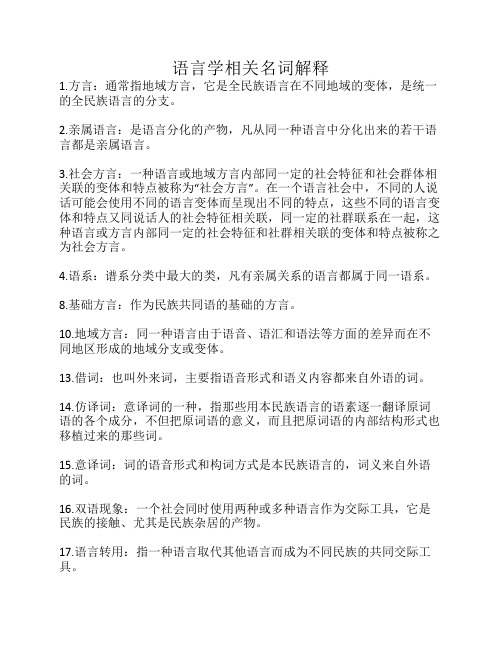
语言学相关名词解释1.方言:通常指地域方言,它是全民族语言在不同地域的变体,是统一的全民族语言的分支。
2.亲属语言:是语言分化的产物,凡从同一种语言中分化出来的若干语言都是亲属语言。
3.社会方言:一种语言或地域方言内部同一定的社会特征和社会群体相关联的变体和特点被称为“社会方言”。
在一个语言社会中,不同的人说话可能会使用不同的语言变体而呈现出不同的特点,这些不同的语言变体和特点又同说话人的社会特征相关联,同一定的社群联系在一起,这种语言或方言内部同一定的社会特征和社群相关联的变体和特点被称之为社会方言。
4.语系:谱系分类中最大的类,凡有亲属关系的语言都属于同一语系。
8.基础方言:作为民族共同语的基础的方言。
10.地域方言:同一种语言由于语音、语汇和语法等方面的差异而在不同地区形成的地域分支或变体。
13.借词:也叫外来词,主要指语音形式和语义内容都来自外语的词。
14.仿译词:意译词的一种,指那些用本民族语言的语素逐一翻译原词语的各个成分,不但把原词语的意义,而且把原词语的内部结构形式也移植过来的那些词。
15.意译词:词的语音形式和构词方式是本民族语言的,词义来自外语的词。
16.双语现象:一个社会同时使用两种或多种语言作为交际工具,它是民族的接触、尤其是民族杂居的产物。
17.语言转用:指一种语言取代其他语言而成为不同民族的共同交际工具。
18.洋泾浜语:这是汉语对混杂语言的称呼,指母语不同的人在相互交际时所使用的两种或多种语言混杂而成的交际工具。
19.克里奥耳语:作用某个社会群体的母语来使用的、由两种或多种语言混合而成的语言。
20.双言现象:指某一言语社团使用两种方言功分别使用共同语和方言的社会现象。
22.非克里奥耳化:克里奥耳语向基础语言的方向发展,使两种语言越来越接近,甚至使克里奥耳语为基础语言的一种变体的现象和过程被称之为非克里奥耳化。
23.语言规划:社会对语言文字问题所作出的有组织、有意识的管理、调节和改进。
语言学概论所有名词解释
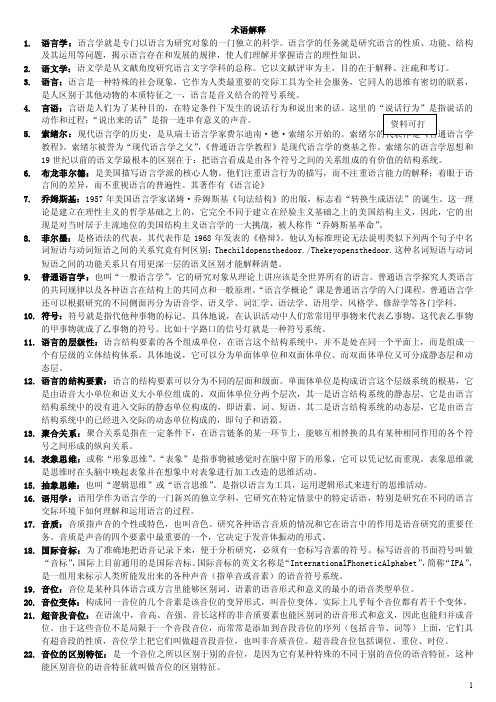
术语解释1.语言学:语言学就是专门以语言为研究对象的一门独立的科学。
语言学的任务就是研究语言的性质、功能、结构及其运用等问题,揭示语言存在和发展的规律,使人们理解并掌握语言的理性知识。
2.语文学:语文学是从文献角度研究语言文字学科的总称。
它以文献评审为主,目的在于解释、注疏和考订。
3.语言:语言是一种特殊的社会现象,它作为人类最重要的交际工具为全社会服务,它同人的思维有密切的联系,是人区别于其他动物的本质特征之一,语言是音义结合的符号系统。
4.言语:言语是人们为了某种目的,在特定条件下发生的说话行为和说出来的话。
这里的“说话行为”是指说话的5.索绪尔:教程》。
索绪尔被誉为“现代语言学之父”,《普通语言学教程》是现代语言学的奠基之作。
索绪尔的语言学思想和19世纪以前的语文学最根本的区别在于:把语言看成是由各个符号之间的关系组成的有价值的结构系统。
6.布龙菲尔德:是美国描写语言学派的核心人物。
他们注重语言行为的描写,而不注重语言能力的解释;着眼于语言间的差异,而不重视语言的普遍性。
其著作有《语言论》7.乔姆斯基:1957年美国语言学家诺姆·乔姆斯基《句法结构》的出版,标志着“转换生成语法”的诞生。
这一理论是建立在理性主义的哲学基础之上的,它完全不同于建立在经验主义基础之上的美国结构主义,因此,它的出现是对当时居于主流地位的美国结构主义语言学的一大挑战,被人称作“乔姆斯基革命”。
8.菲尔墨:是格语法的代表,其代表作是1968年发表的《格辩》。
他认为标准理论无法说明类似下列两个句子中名词短语与动词短语之间的关系究竟有何区别:Thechildopensthedoor./Thekeyopensthedoor.这种名词短语与动词短语之间的功能关系只有用更深一层的语义区别才能解释清楚。
9.普通语言学:也叫“一般语言学”,它的研究对象从理论上讲应该是全世界所有的语言。
普通语言学探究人类语言的共同规律以及各种语言在结构上的共同点和一般原理。
语言学的名词解释

语言学的名词解释引言语言学是研究语言的结构、规律和变化的学科。
作为一门学科,语言学涉及广泛的领域,涵盖了词汇、语法、语音、语义等多个方面。
在语言学研究中,有许多重要的名词需要解释,这些名词有助于我们理解语言学的基本概念和理论。
本文将介绍几个语言学中常用的名词,并对其进行解释。
语音学1. 语音语音是指人类使用声音来进行交流和表达意思的能力。
在语音学中,语音是指语言的声音单位,包括语音的产生、分类和描述等方面。
2. 语音学语音学是研究语音的学科。
它研究语音的产生、传播、感知和分类等问题,对语音的音素、音节、音系等进行描述和分析。
3. 音素音素是语言中最小的音位单位。
一个音素可以通过替换使一个音与另外一个音有所区别。
音素可用于建立音位对比,对研究语音的差异和系统性做出描述。
4. 音节音节是语言中的基本语音单位。
它由一段连续的声音组成,包括一个或多个音素。
音节在构成词语时具有重要的作用,不同语言对音节的组合和结构有不同的规律。
语法学1. 语法语法是描述语言结构和规则的学科。
它研究语言中单词和句子之间的关系,以及语言的句法规则。
语法可以分为句法、词法、句子成分等多个层面。
2. 句法句法是语法学中研究句子结构和组织的分支。
它研究句子的成分和关系,包括主谓结构、宾语、修饰语等。
3. 词法词法是语法学中研究词汇和词法规则的分支。
它研究词汇的构成和分类,包括词根、词缀、词义等方面。
4. 句子成分句子成分是组成句子的不可再分的最小单位。
在句子中,包括主语、谓语、宾语、定语、状语等多个句子成分,它们各自具有不同的语法功能。
语义学1. 语义语义是研究词义和语言意义的学科。
它研究词汇和句子的意义,以及语言表达的信息和引申。
2. 语义学语义学是研究语言意义的学科。
它研究语言中的词义、句义、语境等方面的问题,揭示词语和句子的真正含义。
3. 词义词义是一个词所具有的意义。
在语义学中,词义可以通过定义、例句和语境等方式来解释和理解。
语言学术语

语言学术语介绍本文档旨在介绍一些常见的语言学术语,以帮助读者更好地理解语言学领域的相关概念和术语。
术语解释以下是一些常见的语言学术语及其解释:1. 语言学:语言学是研究语言的科学。
它涵盖了语言的结构、历史、使用和变化等方面。
语言学:语言学是研究语言的科学。
它涵盖了语言的结构、历史、使用和变化等方面。
2. 语音学:语音学是研究语音的学科,它关注语音的产生、传播和感知。
语音学:语音学是研究语音的学科,它关注语音的产生、传播和感知。
3. 语法:语法是研究句子结构和语法规则的学科。
它涉及词类、短语和句子的形成和组织。
语法:语法是研究句子结构和语法规则的学科。
它涉及词类、短语和句子的形成和组织。
4. 词汇学:词汇学是研究词汇的学科。
它关注词汇的构成、意义和使用。
词汇学:词汇学是研究词汇的学科。
它关注词汇的构成、意义和使用。
5. 句法学:句法学是研究句子结构和句法关系的学科。
它探讨句子中词汇和短语的排列和组合方式。
句法学:句法学是研究句子结构和句法关系的学科。
它探讨句子中词汇和短语的排列和组合方式。
6. 语义学:语义学是研究语义(意义)的学科,它涉及词汇和句子意义的形成和解释。
语义学:语义学是研究语义(意义)的学科,它涉及词汇和句子意义的形成和解释。
7. 语用学:语用学是研究语言使用情境和交际的学科。
它关注语言在特定情境中的意义和目的。
语用学:语用学是研究语言使用情境和交际的学科。
它关注语言在特定情境中的意义和目的。
8. 语音:语音是指语言中的声音单元。
它包括语音音素、音节和音调等。
语音:语音是指语言中的声音单元。
它包括语音音素、音节和音调等。
9. 音标:音标是用来表示语音的符号系统。
它可以用来记录和描述各种语音发音。
音标:音标是用来表示语音的符号系统。
它可以用来记录和描述各种语音发音。
10. 文字:文字是指用来书写语言的符号系统。
不同语言使用不同的文字系统。
文字:文字是指用来书写语言的符号系统。
不同语言使用不同的文字系统。
parole语言学名词解释(一)
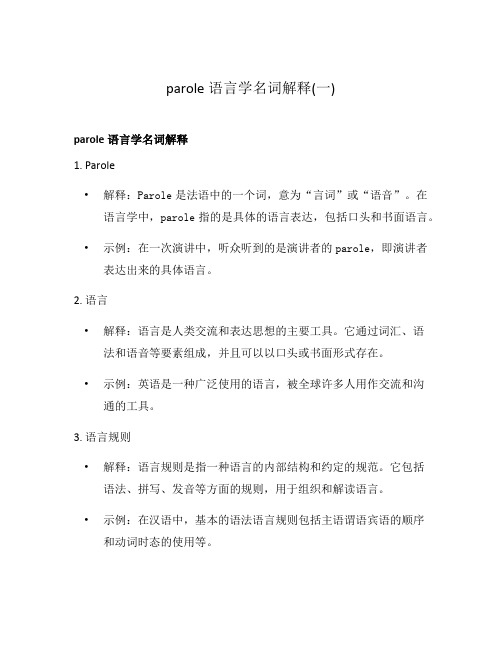
parole语言学名词解释(一)parole语言学名词解释1. Parole•解释:Parole是法语中的一个词,意为“言词”或“语音”。
在语言学中,parole指的是具体的语言表达,包括口头和书面语言。
•示例:在一次演讲中,听众听到的是演讲者的parole,即演讲者表达出来的具体语言。
2. 语言•解释:语言是人类交流和表达思想的主要工具。
它通过词汇、语法和语音等要素组成,并且可以以口头或书面形式存在。
•示例:英语是一种广泛使用的语言,被全球许多人用作交流和沟通的工具。
3. 语言规则•解释:语言规则是指一种语言的内部结构和约定的规范。
它包括语法、拼写、发音等方面的规则,用于组织和解读语言。
•示例:在汉语中,基本的语法语言规则包括主语谓语宾语的顺序和动词时态的使用等。
4. 句子•解释:句子是由一个或多个词组成的表达完整意义的语言单位。
它通常包含主语和谓语,并且能够独立表达一个完整的想法。
•示例:“I like to read books.”是一个简单的英文句子,它包含了主语“I”、谓语“like” 和宾语“books”。
5. 词汇•解释:词汇是一种语言所包含的所有单词的集合。
它是语言中的基本单位,用于表达概念、事物和动作等。
•示例:英语的词汇包括大量的名词、动词、形容词等,如“dog”、“run” 和“beautiful”。
6. 语法•解释:语法是研究句子和短语如何组成的一门学科。
它规定了句子的结构、成分之间的关系以及词法和句法规则。
•示例:英语语法包括主谓一致、时态和语态等规则,用于正确构造句子。
7. 发音•解释:发音是指语言中语音的产生、传播和接收过程。
它涉及声音的发音部位、音调、语调和音素等因素。
•示例:汉语的发音基于声母、韵母和声调的组合,不同的发音方式会导致词义的不同。
8. 书面语言•解释:书面语言是指用于书写和阅读的语言形式。
它相对于口头语言来说更加正式、规范并具有一定的固定性。
•示例:报纸文章和学术论文等都属于书面语言的范畴,具有明确的结构和专业术语的使用。
语言学术语表

语言学术语表
以下是一些常见的语言学术语及其解释:
1. 语言:人类沟通和表达思想的系统,由声音、符号和语法组成。
2. 语言学:研究语言的科学,探讨语言的结构、历史演变、语音、语义、句法等方面。
3. 语音学:研究语言音素(声音单元)的科学,包括语音产生、感知和语音单位的分类等。
4. 语义学:研究语言意义的学科,涉及词义、句子意义和语言表达的逻辑关系等。
5. 语法学:研究语言结构和句子构成的学科,包括词法、句法、语法规则和句子解构等。
6. 语用学:研究语言用法和语境影响的学科,探讨话语的目的、推理和指称等。
7. 词法:研究词汇形态学和词汇构成规则的学科,包括词的形态变
化和词缀的作用等。
8. 句法:研究句子结构和句子成分之间关系的学科,包括主谓宾结构、短语结构和句子类型等。
9. 语言变化:研究语言随时间变化的学科,包括语音变化、词汇演
变和语法变异等。
10. 语言联系:研究多种语言之间相互影响的学科,包括语言接触、语言借用和二语习得等。
11. 语言族系:相互关联的语言的系统分类,根据语音、词汇和语
法等特征划分。
12. 语言地理分布:各种语言在地理上的分布情况,包括语言家族
的分布和方言的分布等。
13. 联系语言学:比较和对比多种语言的学科,探索语言之间的共
性和差异。
14. 语言规范:对语言使用的标准和规则的规范,包括正式语法规范和标准发音等。
15. 语言习得:人类掌握和使用语言的过程,包括婴儿语言习得和二语习得等。
这些是一些常见的语言学术语,涵盖了语言学的各个方面。
语言学术语表
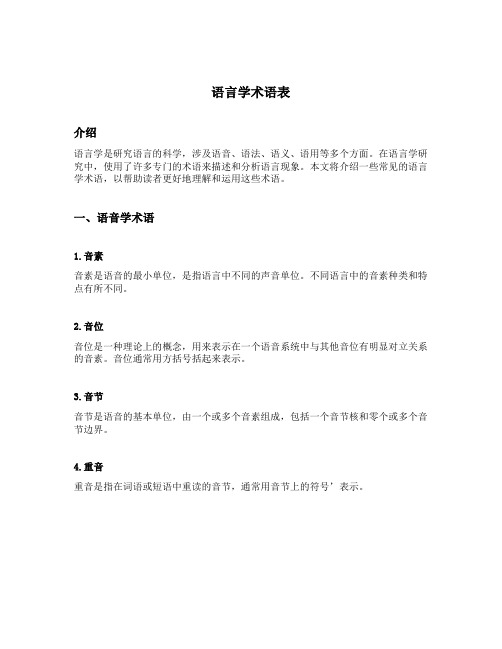
语言学术语表介绍语言学是研究语言的科学,涉及语音、语法、语义、语用等多个方面。
在语言学研究中,使用了许多专门的术语来描述和分析语言现象。
本文将介绍一些常见的语言学术语,以帮助读者更好地理解和运用这些术语。
一、语音学术语1.音素音素是语音的最小单位,是指语言中不同的声音单位。
不同语言中的音素种类和特点有所不同。
2.音位音位是一种理论上的概念,用来表示在一个语音系统中与其他音位有明显对立关系的音素。
音位通常用方括号括起来表示。
3.音节音节是语音的基本单位,由一个或多个音素组成,包括一个音节核和零个或多个音节边界。
4.重音重音是指在词语或短语中重读的音节,通常用音节上的符号’表示。
1.词类词类是用来分类词语的一种方式,常见的词类包括名词、动词、形容词、副词等。
2.句子句子是用来表达完整意义的语言单位,通常包括主语、谓语和宾语等成分。
3.短语短语是由词语组成的一个语言单位,包括名词短语、动词短语、形容词短语等。
4.主谓一致主谓一致是指主语和谓语在人称和数上保持一致,是语法中一个重要的原则。
三、语义学术语1.词义词义是指词语所具有的意义,包括字面义和引申义两种。
2.同义词同义词是指具有相同或相近词义的词语,可以在一定程度上互换使用。
3.反义词反义词是指意义相对、相反的词语,可以用来表达相反的概念。
4.上下位词上下位词是指表示具体事物和一般概念之间的关系的词语,如“苹果”和“水果”的关系。
1.语用语用是指语言在具体交际实践中的使用和理解。
2.语用推断语用推断是指通过上下文和语境等信息来推断语言表达的意义。
3.语用失误语用失误是指由于不当的语言使用导致的交际上的错误或误解。
4.言外之意言外之意是指在言辞之外所蕴含的意义,需要通过语境等信息进行理解。
以上仅是语言学中的一部分学术术语,通过学习和应用这些术语,可以更好地认识和分析语言现象,提高语言能力和语言理解的水平。
希望本文能够帮助读者理解和运用这些语言学术术语,进一步探索语言学的奥秘。
语言学名词解释汇总
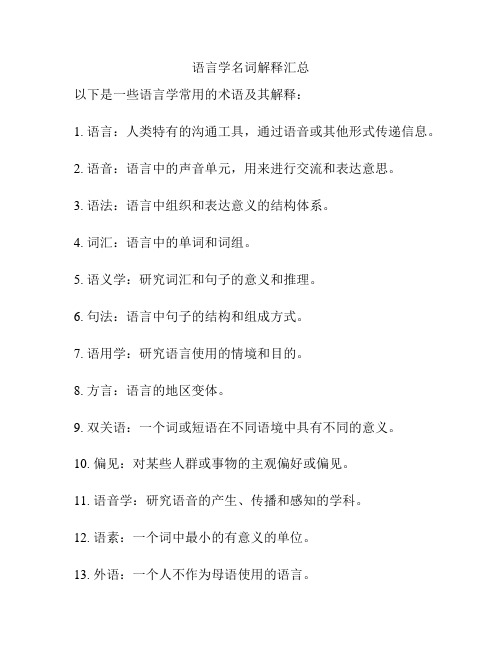
语言学名词解释汇总
以下是一些语言学常用的术语及其解释:
1. 语言:人类特有的沟通工具,通过语音或其他形式传递信息。
2. 语音:语言中的声音单元,用来进行交流和表达意思。
3. 语法:语言中组织和表达意义的结构体系。
4. 词汇:语言中的单词和词组。
5. 语义学:研究词汇和句子的意义和推理。
6. 句法:语言中句子的结构和组成方式。
7. 语用学:研究语言使用的情境和目的。
8. 方言:语言的地区变体。
9. 双关语:一个词或短语在不同语境中具有不同的意义。
10. 偏见:对某些人群或事物的主观偏好或偏见。
11. 语音学:研究语音的产生、传播和感知的学科。
12. 语素:一个词中最小的有意义的单位。
13. 外语:一个人不作为母语使用的语言。
14. 语义角色:句子中表示动作的参与者和受益者的角色。
15. 同音异义词:发音相同但意义不同的词。
16. 语体:语言在不同社会和文化环境下的变体。
17. 口音:由不同语音特征引起的发音差异。
18. 父语:一个人从小学习和使用的第一种语言。
19. 旁观者理论:社会心理学概念,指的是观察者对特定语言
和文化的理解。
20. 叙事学:研究叙述结构和故事生成的学科。
这只是一些常用的语言学术语,语言学是一个非常广泛的学科,还有很多其他的术语可供学习和研究。
术语解释

《语言学》术语解释:1.语系:(1)语系是按照“谱系分类”的方法,根据语言间亲属关系的有无,把世界上的语言所分成的不同的类,凡是有亲属关系的语言都属于同一语系,反之则属于不同的语系。
(2)比如汉语、藏语、壮语、傣语、苗语等是亲属语言。
它们都属于汉藏语系。
(3)世界上的诸语言按其亲属关系大致可以分为汉藏语系、印欧语系、乌拉尔语系、阿尔泰语系、闪含语系、高加索语系、达罗毘语系、马来—玻利尼西亚语系、南亚语系九大语系。
2.歧义:歧义句是在理解上会产生两种可能的句子,换句话说,就是可以这样理解也可以那样理解的句子。
也就是谓语言文字的意义不明确,有两种或几种可能的解释。
一个句子有两种或两种以上的解释,就会产生歧义,歧义产生的原因:词义不明确、句法不固定、层次不分明、指代不明歧义有主要由口语与书面的差别造成的,有主要由多义词造成的,还有语言组合造成的。
组合的歧义中又有语法组合的歧义和语义组合的歧义。
3符号1.符号就是由一定的形式构成的表示一定意义的记号或标记,它包括形式和意义两个方面,指称现实现象。
例如红绿灯就是一种符号,红灯表示“停止“的意义。
符号是人们共同约定用来指称一定对象的标志物,它可以包括以任何形式通过感觉来显示意义的全部现象。
在这些现象中某种可以感觉的东西就是对象及其意义的体现者它有两个方面的内涵:一方面它是意义的载体,是精神外化的呈现;另一方面它具有能被感知的客观形式。
3.字母:拼音文字或注音符号的最小书写单位。
如:英文字母;汉语拼音字母。
4.基础方言:(1)一种语言的共同语并不是凭空产生的,而是在某一个方言的基础上形成的,这种作为共同语基础的方言叫做“基础方言”。
(2)所谓作为共同语的基础指共同语的语音、语汇和语法系统主要来自基础方言。
(3)例如,意大利共同语的基础方言是多斯岗方言,现代汉民族共同语的基础方言是北方方言。
5.共同语:指一个部落或民族内部大多数成员所共同掌握和使用的语言。
它是在某个区域的人们在日常生活中以口语的形式逐渐形成的。
语言学概论复习(完整)
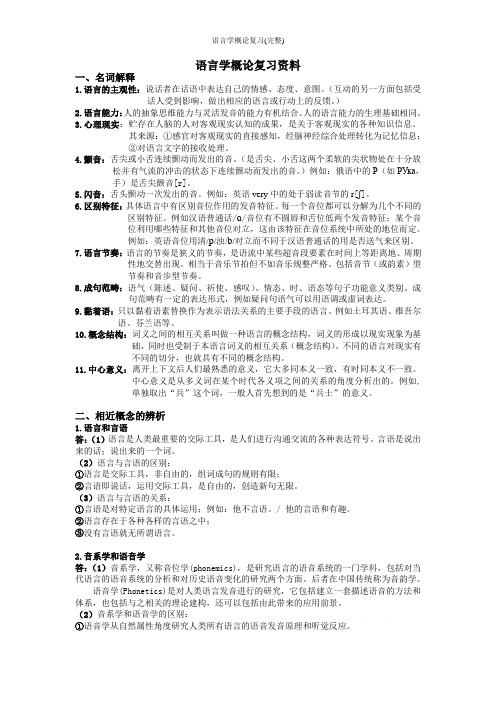
语言学概论复习资料一、名词解释1.语言的主观性:说话者在话语中表达自己的情感、态度、意图。
(互动的另一方面包括受话人受到影响,做出相应的语言或行动上的反馈。
)2.语言能力:人的抽象思维能力与灵活发音的能力有机结合。
人的语言能力的生理基础相同。
3.心理现实:贮存在人脑的人对客观现实认知的成果,是关于客观现实的各种知识信息。
其来源:①感官对客观现实的直接感知,经脑神经综合处理转化为记忆信息;②对语言文字的接收处理。
4.颤音:舌尖或小舌连续颤动而发出的音。
(是舌尖、小舌这两个柔软的尖状物处在十分放松并有气流的冲击的状态下连续颤动而发出的音。
)例如:俄语中的Р(如РУка,手)是舌尖颤音[r]。
5.闪音:舌头颤动一次发出的音。
例如:英语very中的处于弱读音节的r[ʃ]。
6.区别特征:具体语言中有区别音位作用的发音特征。
每一个音位都可以分解为几个不同的区别特征。
例如汉语普通话/ɑ/音位有不圆唇和舌位低两个发音特征;某个音位利用哪些特征和其他音位对立,这由该特征在音位系统中所处的地位而定。
例如:英语音位用清/p/浊/b/对立而不同于汉语普通话的用是否送气来区别。
7.语言节奏:语言的节奏是狭义的节奏,是语流中某些超音段要素在时间上等距离地、周期性地交替出现。
相当于音乐节拍但不如音乐规整严格。
包括音节(或韵素)型节奏和音步型节奏。
8.成句范畴:语气(陈述、疑问、祈使、感叹)、情态、时、语态等句子功能意义类别。
成句范畴有一定的表达形式,例如疑问句语气可以用语调或虚词表达。
9.黏着语:只以黏着语素替换作为表示语法关系的主要手段的语言。
例如土耳其语、维吾尔语、芬兰语等。
10.概念结构:词义之间的相互关系叫做一种语言的概念结构,词义的形成以现实现象为基础,同时也受制于本语言词义的相互关系(概念结构)。
不同的语言对现实有不同的切分,也就具有不同的概念结构。
11.中心意义:离开上下文后人们最熟悉的意义,它大多同本义一致,有时同本义不一致。
语言学术语表

语言学术语表语言学术语表语言学术语表是一个收录了语言学领域中常用术语及其解释的资源。
它旨在帮助学习语言学的人更好地理解和运用这些术语。
以下是一些常见的语言学术语及其解释:1. 语音学:研究语音及其在语言中的功能和规律的学科。
研究的内容包括音位、音素、音节、音系等。
2. 语法学:研究语言的结构和规则的学科。
研究的内容包括句法、词法、语义等。
3. 语义学:研究语言的意义和符号的学科。
研究的内容包括词义、句义、逻辑等。
4. 语用学:研究语言使用的学科。
研究的内容包括言语行为、会话分析、言外之意等。
5. 语言变体:指同一语言在不同地区、社会群体或语言社群中具有的差异。
这些差异可能涉及发音、词汇、语法等方面。
6. 语言接触:指两种或多种不同语言之间的相互影响。
这种影响可能产生语言借用、语言迁移等现象。
7. 语言演化:指语言随着时间的推移而发生变化的过程。
语言演化可能包括语音演化、语法演化、词汇演化等方面。
8. 语言习得:指个体从婴儿期开始学习一种或多种语言的过程。
语言习得可能包括语音习得、词汇习得、语法习得等方面。
9. 语言教学:指通过各种教学方法和技术帮助学习者习得一种或多种语言的过程。
语言教学可能包括听说读写、文化交流等方面。
除了上述术语之外,语言学术语表还可以包括更多的专业术语,如音韵学、文字学、翻译学、语料库等。
这些术语的解释可以帮助读者更好地理解语言学的相关概念和理论。
语言学术语表的创建旨在方便学习语言学的人查阅和学习相关术语。
通过对术语的解释和说明,读者可以更全面地了解语言学的知识和研究领域。
此外,语言学术语表还可以促进语言学研究者之间的交流和合作,提供一个共享和讨论语言学术语的平台。
语言学纲要意译词举例 -回复
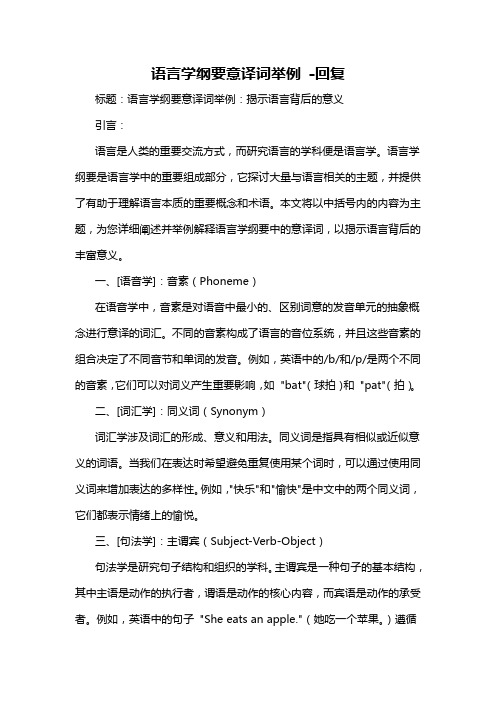
语言学纲要意译词举例-回复标题:语言学纲要意译词举例:揭示语言背后的意义引言:语言是人类的重要交流方式,而研究语言的学科便是语言学。
语言学纲要是语言学中的重要组成部分,它探讨大量与语言相关的主题,并提供了有助于理解语言本质的重要概念和术语。
本文将以中括号内的内容为主题,为您详细阐述并举例解释语言学纲要中的意译词,以揭示语言背后的丰富意义。
一、[语音学]:音素(Phoneme)在语音学中,音素是对语音中最小的、区别词意的发音单元的抽象概念进行意译的词汇。
不同的音素构成了语言的音位系统,并且这些音素的组合决定了不同音节和单词的发音。
例如,英语中的/b/和/p/是两个不同的音素,它们可以对词义产生重要影响,如"bat"(球拍)和"pat"(拍)。
二、[词汇学]:同义词(Synonym)词汇学涉及词汇的形成、意义和用法。
同义词是指具有相似或近似意义的词语。
当我们在表达时希望避免重复使用某个词时,可以通过使用同义词来增加表达的多样性。
例如,"快乐"和"愉快"是中文中的两个同义词,它们都表示情绪上的愉悦。
三、[句法学]:主谓宾(Subject-Verb-Object)句法学是研究句子结构和组织的学科。
主谓宾是一种句子的基本结构,其中主语是动作的执行者,谓语是动作的核心内容,而宾语是动作的承受者。
例如,英语中的句子"She eats an apple."(她吃一个苹果。
)遵循了主谓宾结构。
四、[语义学]:语义角色(Semantic Role)语义学是研究语言中词语和句子意义的学科。
语义角色是指在句子中扮演不同角色的成分,它们描述了事件或动作中不同参与者的关系。
例如,在句子"The cat chased the mouse."(猫追逐老鼠。
)中,"猫"是执行追逐动作的"动作者",而"老鼠"是动作的"承受者"。
语言学术语解释和举例

语⾔学术语解释和举例1. Sequential Rules [s?'kwen?(?)l] 序列规则Sequential Rules are rules thatgovern the combination of sounds in particular language.e.g. If a word begins with a /l/ or /r/, then the next sound must be a vowel(元⾳).2. Prototype ['pr??t?ta?p]原型What members of a particular community think of as the typical instance of a lexical category.e.g. F or some English speakers “cabbage”(rather than say carrot) might be theprototypical vegetable.3. Presuppositional Trigger 预设触发语A presupposition trigger is a construction or item that signals the existence of apresupposition in an utterance.e.g.” Jane had another date with John.” It presupposes the fact that Jane has had onedate with John before. Apparently, the use of “another” called a presupposition trigger.4. Possessor [p?'zes?] 所有⼈Refers to one who has somethinge.g. Jane’s doll. The first noun is the possessor.5. Positive Face 积极⾯⼦The positive consistent self-image or “personality”(including the desire that this self-image be appreciated and approved of)claimed by interactants.e.g.: You are excellent.6. Phoneme ['f??ni?m] ⾳位The smallest unit in the sound systemof a languagee.g. the two words peak and speak, we are aware that the sound /p/ is pronounceddifferently7. Performative Utterance ⾔有所为It is a sentence which is not true or false but instead 'happy' or 'unhappy', and which is uttered in the performance of an illocutionary (语内表现⾏为的) act rather than used to state something.e.g. "I swear to do that", "I promise to be there"8. Negative Face 消极⾯⼦The basic claim to territories, personal preserves, rights to non-distraction. i.e. to freedom of action and freedom from imposition.e.g.: You’d better not smoke here.9. Morpheme ['m?:fi:m] 词素The smallest meaningful unit of language. It can not be divided without altering or destroying its meaning.e.g. the English word unkindness consists of three morphemes: the S TEM1 kind, thenegative prefix un-, and the noun-forming suffix -ness.10. Metonymic Reasoning [,met?'nimik] 转喻推理Metonymic Reasoning is a figure of speech used in rhetoric(修辞) in which a thing or concept is not called by its own name, but by the name of something intimately(密切地) associated with that thing or concept.For instance, "London", as the capital of the United Kingdom, can be used as a metonym (an instance of metonymy) for the British governmente.g:silk suits you.”silk stands for the cloth made of silk.11. Truth-conditional Semantics 语义真值条件Truth-conditional Semantics is an approach to semantics(语义学) of natural language that sees the meaning of assertions as being the same as, or reducible to, the truth conditions of that sentence..For example, 'snow is white'.12. Theme [θi?m] 主题Refers to one or thing that undergoes an actione.g.sam found the dog.13. Synonymy [s?'n?n?m?] 近义词/同义词Synonyms are words which have different forms but similar meanings.e.g. Start, begin, commenc e14. Syllable ['s?l?b(?)l] ⾳节Syllable is phonological unit which is composed of one or more phonemes.. Every syllable has a nucleus, which is usually a vowel.For example, /let/ consists of one syllable, whereas /ri’ga:d/ consists of two syllables. 15. Source 来源Refers to the place from which an action originates.For example, Sam left Beijing for Nanjing.16. Metaphoric Reasoning 隐喻性思维A word or phrase which is used for special effect, and which does not have its usual or literal meaninge.g. My hands are as cold as ice.17. Location 位置Refers to the place where an action happens,e.g. Jane put the magazines on the table. The table is location.18. Instrument ⼯具Refers to the means by which an action is performed.For example, the key opened the door.19. Indirect Speech Act 间接⾔语⾏为A speech act in which the communicative intention is not reflected in the linguistic form of the utteranceFor example, “It is very hot in here” may be used to e xpress a request to turn on the air conditioner.20. Impersonalization [im,p?:s?n?lai'zei??n] ⾮⼈格化A device used either to avoid mentioning oneself or the interlocutor(对话者), or to appeal to public rule or institutional regulation, which helps to gain successful interpersonal communication.e.g. (1)I don’t think you can smoke in the waiting room, sir. (2)Smoking is not allowed in the waiting room, sir. Obviously, (2) is more polite than (1).21. Hyponymy [ha?'p?n?m?] 下义词A relationship between two words, in which the meaning of one word includes the meaning of the other words.e.g. tiger, lion, elephant and dog are hyponyms of the word animal.22. Goal ⽬标Refers to the place to which an action is directed.For example, Sam left Beijing for Nanjing.23. Functional Shift 词性转换Words may shift from one part of speech to another without the addition of affixes.e.g. noun to verb, to knee, to tape, to break.24. Family Resemblance 家族类似性That a lexical category(词汇范畴) resembles another one can be called family resemblance.e.g. the notion概念of game. One game may resemble类似at least one game, although not all of them have to be alike at the same time.25. Experiencer 感受者One who perceives something. Example: Sam was sad.26. Exophoric Reference [,eks?u'f?rik] 外指Refers to the relation between an entity in the situational context and a linguistic item in the texte.g. he is the man you want to see, said when the mentioned person comes up to the speaker.27. Entailment 限定关系The relationship between two sentences in which the truth of the second is inferred from the truth of the firste.g. john has a boy”entailing”john has a child”.28. Endophoric Reference 内指照应Refers to a relation between two linguistic items in the same texte.g. John loves Jane, he takes great care of her. This is known to all.29. Deictic Exprseeion ['daiktik] 指代表达(指⽰语)Deictic Exprseeion are linguistic items used to anchor these specific points in the communication event.e.g. here and there, which refer to a place in relation to the speaker: The letter is here. (near the speaker). The letter is over there. (further away from the speaker)30. Coordinate Sentence 并列句contains two or more clauses(从句) are conjoined by a linking word, such as “and”, “or”, “so”, or “but”.e.g. here a star, and there a star31. Constative Utterance [k?n'steitiv] ['?t?r?ns] 表述句It’s the descriptions of facts or states of affairs. For example, The earth is round.”32. Componential Analysis 语义成分分析The process that breaks down the meaning of a word into its minimal distinctive features or properties using feature symbolsis called componential analysis.For example, boy may be shown as [+human] [+male] [-adult]33. Complex Sentence 复合句A sentence which contains one or more clauses are embedded(嵌) into a main clause to communicate purpose, reason, time, place, manner, or concession.e.g.this is the place where my father worked 10 years ago.34. Clause 从句A clause in English is one unit of organization that contains a subject-predicate structure..A clause may be finite or non-finite.e.g. I hurried home. / Because I was late, they went without me.35. Causative ['k?:z?tiv] 成为..的原因/使动词A natural force that causes a changeFor example, The flood killed 25.36. Cataphoric Reference [,k?t?'f?:rik] 后指照应Donates a relation between the current pronominal item and the later occurring expressione.g. This is what John does for Jane, he sends a bunch of roses to her every day.37. Blending ['blendi?]混成法Blending s a word formed by combining parts of other wordse.g. smog (formed from smoke and fog)38. Back-formation 逆构(逆成法)New words may be created from already existing words by subtracting a real or supposed affix.e.g. the word “edit” from the pre-existing word “editor” by deleting the assumed suffix “-or”39. Antonymy [?n't?nimi] 反义Antonyms are words which are opposite in meaning.e.g. Dead and alive; male and female40. Anaphoric Reference [,?n?'f?rik] 前指Involves a relation between a preceding referential expression and the current pronominal iteme.g. John loves Jane, he takes great care of her. This is known to all.41. Analogy [?'n?l?d?i] 类⽐The process by which words are reformed or created on the model of existing grammatical termsFor example, zipper-gate, football-gate, Watergate42. Allophone ['?l?uf?un] ⾳位变体Allophone is the phonetic variants of a phoneme in a particular language.e.g. the phoneme /l/ in English can be realized as dark/l/, clear /l/.43. Agent ⼈物,主格Refers to the one who performs an actionFor example, Sam opened the door.44. Affixation [,?fik'sei??n] 词缀A bound morpheme that is joined before, after, or within a root or stemIt mainly includes prefixes, suffixes, infixese.g. prefix un-, suffix –ness;infix –foot45. Adjacency Pair [?'d?eis?nsi] 相邻语对An initiation, say a question or a request, by the first speaker and the response by the second speaker, like an answer to the question or compliance with the request, form an adjacency pair.For example, “what’s your name?”“My name is Tom.”。
- 1、下载文档前请自行甄别文档内容的完整性,平台不提供额外的编辑、内容补充、找答案等附加服务。
- 2、"仅部分预览"的文档,不可在线预览部分如存在完整性等问题,可反馈申请退款(可完整预览的文档不适用该条件!)。
- 3、如文档侵犯您的权益,请联系客服反馈,我们会尽快为您处理(人工客服工作时间:9:00-18:30)。
1. Sequential Rules [sɪ'kwenʃ(ə)l] 序列规则Sequential Rules are rules thatgovern the combination of sounds in particular language.e.g. If a word begins with a /l/ or /r/, then the next sound must be a vowel(元音).2. Prototype ['prəʊtətaɪp]原型What members of a particular community think of as the typical instance of a lexical category.e.g. F or some English speakers “cabbage”(rather than say carrot) might be theprototypical vegetable.3. Presuppositional Trigger 预设触发语A presupposition trigger is a construction or item that signals the existence of apresupposition in an utterance.e.g.” Jane had another date with John.” It presupposes the fact that Jane has had onedate with John before. Apparently, the use of “another” called a presupposition trigger.4. Possessor [pə'zesə] 所有人Refers to one who has somethinge.g. Jane’s doll. The first noun is the possessor.5. Positive Face 积极面子The positive consistent self-image or “personality”(including the desire that this self-image be appreciated and approved of)claimed by interactants.e.g.: You are excellent.6. Phoneme ['fəʊniːm] 音位The smallest unit in the sound systemof a languagee.g. the two words peak and speak, we are aware that the sound /p/ is pronounceddifferently7. Performative Utterance 言有所为It is a sentence which is not true or false but instead 'happy' or 'unhappy', and which is uttered in the performance of an illocutionary (语内表现行为的) act rather than used to state something.e.g. "I swear to do that", "I promise to be there"8. Negative Face 消极面子The basic claim to territories, personal preserves, rights to non-distraction. i.e. to freedom of action and freedom from imposition.e.g.: You’d better not smoke here.9. Morpheme ['mɔ:fi:m] 词素The smallest meaningful unit of language. It can not be divided without altering or destroying its meaning.e.g. the English word unkindness consists of three morphemes: the S TEM1 kind, thenegative prefix un-, and the noun-forming suffix -ness.10. Metonymic Reasoning [,metə'nimik] 转喻推理Metonymic Reasoning is a figure of speech used in rhetoric(修辞) in which a thing or concept is not called by its own name, but by the name of something intimately(密切地) associated with that thing or concept.For instance, "London", as the capital of the United Kingdom, can be used as a metonym (an instance of metonymy) for the British governmente.g:silk suits you.”silk stands for the cloth made of silk.11. Truth-conditional Semantics 语义真值条件Truth-conditional Semantics is an approach to semantics(语义学) of natural language that sees the meaning of assertions as being the same as, or reducible to, the truth conditions of that sentence..For example, 'snow is white'.12. Theme [θiːm] 主题Refers to one or thing that undergoes an actione.g.sam found the dog.13. Synonymy [sɪ'nɒnɪmɪ] 近义词/同义词Synonyms are words which have different forms but similar meanings.e.g. Start, begin, commenc e14. Syllable ['sɪləb(ə)l] 音节Syllable is phonological unit which is composed of one or more phonemes.. Every syllable has a nucleus, which is usually a vowel.For example, /let/ consists of one syllable, whereas /ri’ga:d/ consists of two syllables. 15. Source 来源Refers to the place from which an action originates.For example, Sam left Beijing for Nanjing.16. Metaphoric Reasoning 隐喻性思维A word or phrase which is used for special effect, and which does not have its usual or literal meaninge.g. My hands are as cold as ice.17. Location 位置Refers to the place where an action happens,e.g. Jane put the magazines on the table. The table is location.18. Instrument 工具Refers to the means by which an action is performed.For example, the key opened the door.19. Indirect Speech Act 间接言语行为A speech act in which the communicative intention is not reflected in the linguistic form of the utteranceFor example, “It is very hot in here” may be used to e xpress a request to turn on the air conditioner.20. Impersonalization [im,pə:sənəlai'zeiʃən] 非人格化A device used either to avoid mentioning oneself or the interlocutor(对话者), or to appeal to public rule or institutional regulation, which helps to gain successful interpersonal communication.e.g. (1)I don’t think you can smoke in the waiting room, sir. (2)Smoking is not allowed in the waiting room, sir. Obviously, (2) is more polite than (1).21. Hyponymy [haɪ'pɒnɪmɪ] 下义词A relationship between two words, in which the meaning of one word includes the meaning of the other words.e.g. tiger, lion, elephant and dog are hyponyms of the word animal.22. Goal 目标Refers to the place to which an action is directed.For example, Sam left Beijing for Nanjing.23. Functional Shift 词性转换Words may shift from one part of speech to another without the addition of affixes.e.g. noun to verb, to knee, to tape, to break.24. Family Resemblance 家族类似性That a lexical category(词汇范畴) resembles another one can be called family resemblance.e.g. the notion概念of game. One game may resemble类似at least one game, although not all of them have to be alike at the same time.25. Experiencer 感受者One who perceives something. Example: Sam was sad.26. Exophoric Reference [,eksəu'fɔrik] 外指Refers to the relation between an entity in the situational context and a linguistic item in the texte.g. he is the man you want to see, said when the mentioned person comes up to the speaker.27. Entailment 限定关系The relationship between two sentences in which the truth of the second is inferred from the truth of the firste.g. john has a boy”entailing”john has a child”.28. Endophoric Reference 内指照应Refers to a relation between two linguistic items in the same texte.g. John loves Jane, he takes great care of her. This is known to all.29. Deictic Exprseeion ['daiktik] 指代表达(指示语)Deictic Exprseeion are linguistic items used to anchor these specific points in the communication event.e.g. here and there, which refer to a place in relation to the speaker: The letter is here. (near the speaker). The letter is over there. (further away from the speaker)30. Coordinate Sentence 并列句contains two or more clauses(从句) are conjoined by a linking word, such as “and”, “or”, “so”, or “but”.e.g. here a star, and there a star31. Constative Utterance [kən'steitiv] ['ʌtərəns] 表述句It’s the descriptions of facts or states of affairs. For example, The earth is round.”32. Componential Analysis 语义成分分析The process that breaks down the meaning of a word into its minimal distinctive features or properties using feature symbols is called componential analysis.For example, boy may be shown as [+human] [+male] [-adult]33. Complex Sentence 复合句A sentence which contains one or more clauses are embedded(嵌) into a main clause to communicate purpose, reason, time, place, manner, or concession.e.g.this is the place where my father worked 10 years ago.34. Clause 从句A clause in English is one unit of organization that contains a subject-predicate structure..A clause may be finite or non-finite.e.g. I hurried home. / Because I was late, they went without me.35. Causative ['kɔ:zətiv] 成为..的原因/使动词A natural force that causes a changeFor example, The flood killed 25.36. Cataphoric Reference [,kætə'fɔ:rik] 后指照应Donates a relation between the current pronominal item and the later occurring expressione.g. This is what John does for Jane, he sends a bunch of roses to her every day.37. Blending ['blendiŋ]混成法Blending s a word formed by combining parts of other wordse.g. smog (formed from smoke and fog)38. Back-formation 逆构(逆成法)New words may be created from already existing words by subtracting a real or supposed affix.e.g. the word “edit” from the pre-existing word “editor” by deleting the assumed suffix “-or”39. Antonymy [æn'tɔnimi] 反义Antonyms are words which are opposite in meaning.e.g. Dead and alive; male and female40. Anaphoric Reference [,ænə'fɔrik] 前指Involves a relation between a preceding referential expression and the current pronominal iteme.g. John loves Jane, he takes great care of her. This is known to all.41. Analogy [ə'nælədʒi] 类比The process by which words are reformed or created on the model of existing grammatical termsFor example, zipper-gate, football-gate, Watergate42. Allophone ['æləufəun] 音位变体Allophone is the phonetic variants of a phoneme in a particular language.e.g. the phoneme /l/ in English can be realized as dark/l/, clear /l/.43. Agent 人物,主格Refers to the one who performs an actionFor example, Sam opened the door.44. Affixation [,æfik'seiʃən] 词缀A bound morpheme that is joined before, after, or within a root or stemIt mainly includes prefixes, suffixes, infixese.g. prefix un-, suffix –ness;infix –foot45. Adjacency Pair [ə'dʒeisənsi] 相邻语对An initiation, say a question or a request, by the first speaker and the response by the second speaker, like an answer to the question or compliance with the request, form an adjacency pair.For example, “what’s your name?”“My name is Tom.”。
